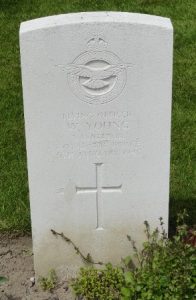Cardiff was granted city status by King Edward VII in 1905. By then it was a thriving metropolis, made wealthy by the export of coal, iron and steel from its docks, and had been swamped by an influx of workers and their families looking for a better life. The Cardiff Borough Police had been formed in 1836, to manage crime in what was then a town, but following its rise to city status, the force was renamed as the Cardiff City Police. A large number of the serving policemen were ex-servicemen, so when the First World War erupted, many of them were mobilised as Army Reservists and went off to war. Some sixteen members of the force died during the conflict, many in the early months of the war. They are commemorated on a war memorial plaque which is located at Cardiff Bay Police Station. There is also another memorial situated at Ocean House in Cardiff, which was removed from the old Central Police Station in Cathays Park, which contains the same names, but is dedicated to the ‘Members of the Cardiff City Police and Fire Brigade Who Fell in the Great War.’ Below the memorial is another to those who fell during the Second World War.
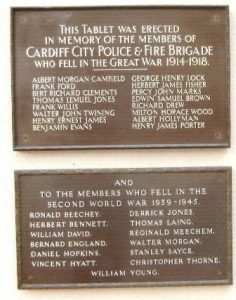
The Great War, 1914-1918
Edwin Samuel Brown, Lance Corporal, 1342, Welsh Guards. Edwin was born in 1891, the son of Alfred Brown and Mary Ann Brown (nee Taylor), of 1, Princes Street, Taunton. He worked with his father as a gardener after leaving school, but then left Taunton to join the Cardiff City Police. Edwin enlisted into the 1st Battalion, Welsh Guards following their formation by Royal Warrant of 26 February 1915. The new regiment trained at White City, before landing at Le Havre on 18 August 1915, becoming attached to 3rd Guards Brigade, Guards Division. The Division saw its first major action during the Battle of Loos, which began on 25 September 1915. During the opening day, the Guards Division began moving into position, watching the terrible scenes in front of them, before launching its own attack on the following morning. At around 18.00 that day the Welsh Guards received orders to attack a feature called Hill 70, and as the men slowly made their way forwards, darkness fell. As soon as the battalion reached the top of the Hill, German machine-gunners opened up a murderous fire on them, forcing the men to dig into the many shell holes littering the crest, before retiring to positions just below of the crest, where the survivors dug-in. The decimated battalion then saw further action around the Hohenzollern Redoubt. The Division had a brief rest in the Calais area, before moving to the Ypres Salient, and held the line at Potijze for several months. At the end of July 1916, the Division withdrew from Ypres and moved to the Somme, before holding the line north of the Ancre for a short period. By 25 August the Guards Division had moved slightly south, and had marched passed Corbie, to Mericourt-L’Abbe. By 9 September the Guards had passed Ginchy, and moved into positions at Guillemont, prior to taking part in the Battle of Flers-Courcelette, the first-time tanks were ever used in action. The Guards Division saw heavy fighting at Flers, and then during the ensuing Battle of Morval, capturing Lesboeufs Village. After the Somme offensive had died down, the Guards remained on the Somme for the winter, and in March 1917 took part in the advance caused by the German Retreat to the Hindenburg Line. Later that year the division moved north to Ypres and fought at the Battle of the Pilckem Ridge, the opening phase of the Passchendaele offensive. The Guards Division saw further fighting at Ypres, during the later stages of the offensive, before being moved south, taking part in the Battle of Cambrai and by the end of November was in the thick of the action again. The division remained in the area over the final winter of the war and were stationed near Gouzeaucourt when the German Spring Offensive hit the area on 21 March 1918. By now Edwin had transferred to the 4th Battalion, Guards Machine Gun Regiment, so would have been in the thick of the fighting. The Germans turned their attention away to the Lys the following month, so the Somme front quietened down. On 8 August the Australian Corps advanced towards the town of Villers Bretonneux and won a mighty battle there against the Germans, thus turning the war. On 21 August the British launched an attack on the Somme, and the Guards Division took part in this great offensive, pushing eastwards towards the Hindenburg Line. The Guards Division was in reserve for the Battle of Havrincourt, but the divisional machine-gunners covered the assault of the 62nd Division. On 27 September 1918 the Guards Division moved into position and began their assault upon the Canal du Nord, along a stretch of the front running south from the Bapaume to Cambrai Road to Lock 7 on the canal. Edwin was killed in action during the assault that day. The 27-year-old was buried in Sanders Keep Military Cemetery, Graincourt-Les-Havrincourt, France.
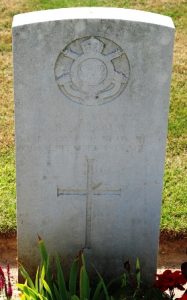
Albert Morgan Camfield, Private, 13200, Grenadier Guards. Albert was born in 1887, the son of Walter Camfield and Bessie Jane Camfield (nee Thomas), of 57, Albert Avenue, Maindee, Newport. He had served in the army as a young man, and after leaving the army joined Cardiff Police Force. By 1911 Albert was lodging at 24, Cyfartha Street, Cardiff. Albert married Edith May Parsons in 1912 and the couple resided at 100, Cryws Road, Cathays, Cardiff. As a former soldier, Albert was an Army Reservist and re-enlisted at Newport into the Grenadier Guards soon after the outbreak of war. He was posted to the 2nd Battalion, Grenadier Guards, which was in barracks at Chelsea, as part of the 4th (Guards) Brigade, 2nd Division. Albert landed at le Havre with the battalion on 15 August 1914, and the entire 2nd Division entrained for the Belgian frontier, taking up positions around the town of Mons. On 23 August 1914 the Germans attacked the city and after a fierce fight, the vastly outnumbered BEF was forced to withdraw. During the epic retreat from Mons, the 2nd Division took part in the Affair of Landrecies and in the Rearguard Actions of Villers-Cotterets, before the German drive on Paris was stopped at the Battle of the Marne, which was fought from 5 September to 12 September. The Germans were then forced to withdraw, taking up positions along the Chemin-des-Dames Ridge, where the BEF attacked them on 13 September. The 2nd Grenadier Guards crossed the Aisne via a pontoon bridge at Pont-Arcy on the following morning, 14 September 1914, before attacking the German positions near a farm near Soupir. Albert was killed in action during the assault that morning. The 27-year-old has no known grave and is commemorated on the La Ferté-Sous-Jouarre Memorial, France.
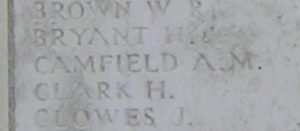
Bert Richard Clements, Private, 14488, Grenadier Guards. Bert was born on 20 April 1892, the son of William Clements and Elizabeth Clements (nee Western), of 30, Brook Street, Barry Dock. He was educated at the council school at Barry Docks, then worked as a telegraph boy at the Barry Post Office for two years prior to enlisting into the Royal Garrison Artillery but was discharged at his mother’s request. He then enlisted into the Grenadier Guards on 2 January 1909 and by 1911 was stationed at Aldershot with the 2nd Battalion, Grenadier Guards. Bert left the army in the spring of 1912 to enlist into Cardiff City Police. As a former soldier he was on the Army Reserve, so upon mobilisation on 4 August 1914, re-joined his battalion, the 2nd Battalion, Grenadier Guards, which was in barracks at Chelsea, as part of the 4th (Guards) Brigade, 2nd Division. Bert landed at le Havre with the battalion on 15 August 1914, and the entire 2nd Division entrained for the Belgian frontier, taking up positions around the town of Mons. On 23 August 1914 the Germans attacked the city and after a fierce fight, the vastly outnumbered BEF was forced to withdraw. During the epic retreat from Mons, the 2nd Division took part in the Affair of Landrecies and in the Rearguard Actions of Villers-Cotterets, before the German drive on Paris was stopped at the Battle of the Marne, which was fought from 5 September to 12 September. The Germans were then forced to withdraw, taking up positions along the Chemin-des-Dames Ridge, where the BEF attacked them on 13 September. This Battle of the Aisne saw the formation of the line of trenches which was to become known as the Western Front, as the Germans dug themselves in along the Chemin-des-Dames, and the BEF began moving to Flanders on 14 October, to prevent the Germans breaking through towards the Channel ports and took over positions guarding the strategically important city of Ypres. On 21 October the 2nd Grenadier Guards took over positions two miles west of Zonnebeke. To their north the 1st Division came under heavy attack that day, whilst on the 2nd Divisions front there was just the odd skirmish. The division launched an attack against Reutel on 25 October, but was beaten back, then on 27 October all hell broke loose, and the Germans attacked in great strength along the Menin Road, hitting positions taken over by the battered 1st Division. The 2nd Division was again outside the main battle zone, holding Polygon Wood, but soon became caught up in the ferocious fighting. Bert was killed in action by enemy shellfire whilst in the trenches at Klein Zillebeke on 7 November 1914. The 22-year-old has no known grave and is commemorated on the Ypres (Menin Gate) Memorial, Belgium.
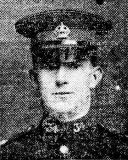
Richard Drew, Private, 60557, Welsh Regiment. Richard was born in 1895, the son of William Drew and Mary Jane Drew (nee Bevan), of 12, Baden Terrace, Penyard, Merthyr Tydfil. He left Merthyr as a young man to enlist into the Cardiff City Police. Richard enlisted into the army in the summer of 1916 and was drafted to France the following spring, before being posted to the 13th Battalion, Welsh Regiment. The battalion, known as the 2nd Rhondda Battalion, had been formed from a core of miners from South Wales and had been in France since December 1915, attached to 114 Brigade, 38th (Welsh) Division. The battalion had moved to Ypres following its epic assault on Mametz Wood in July 1916, taking over the Canal Bank sector at Boesinghe. The infantry battalions of the Division then began carrying out the normal pattern of rotation in the trenches, four days in the front, four in support and four in reserve, whilst also working on trench improvement, digging new trenches, and also carrying out regular patrols and trench raids. On 31 July 1917 the Division launched its famous assault on the Pilckem Ridge, capturing Iron Cross and reaching its objective of the Steenbeek, then dug in along the muddy ditch. Richard was killed in action here on the following day, 1 August 1917. The 22-year-old has no known grave and is commemorated on the Ypres (Menin Gate) Memorial, Belgium.
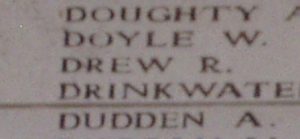
Evan Ellis, Private, 1129, Welsh Guards. Evan was the son of Evan and Margaret Ellis, of Ismael, Llanegryn. He married Priscilla Jones in 1906 prior to becoming a Policeman at Bute Docks, Cardiff. He enlisted at Cardiff into the 1st Battalion, Welsh Guards. The Regiment was raised by Royal Warrant of 26 February 1915, at White City, before landing at Le Havre on 18 August 1915, becoming attached to 3rd Guards Brigade, Guards Division. The Division saw its first major action during the Battle of Loos, which began on 25 September 1915, remaining in the area during the coming months, where they also fought in the subsequent Action of Hohenzollern Redoubt. On 14 December 1915 the Welsh Guards were in the line at Winchester House, when Evan was killed by machine-gun fire. The 33-year-old has no known grave and is commemorated on the Loos Memorial, France. Evan is not commemorated on the Cardiff City Police war memorial, as he was a policeman at the Docks.
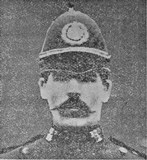
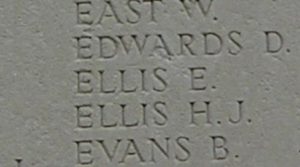
Benjamin Evans, Private, 1348, Welsh Guards. Benjamin was born at Carmarthen in 1890, the son of David Evans and Annie Evans. The family later moved to Byrgwm Mawr, Goytre, Abergavenny. Benjamin left the family farm after enlisting into Cardiff City Police and by 1911 was lodging at 61, Romilly Crescent, Canton with a fellow Policeman. He enlisted at Cardiff into the 1st Battalion, Welsh Guards upon its formation by Royal Warrant on 26 February 1915, and the battalion moved to France on 18 August 1915, where it became attached to the 3rd Guards Brigade, Guards Division. The Division saw its first major action during the Battle of Loos, which began on 25 September 1915. During the opening day, the Guards Division began moving into position, watching the terrible scenes in front of them, before launching its own attack on the following morning. At around 18.00 that day the Welsh Guards received orders to attack a feature called Hill 70, and as the men slowly made their way forwards, darkness fell. As soon as the battalion reached the top of the Hill, German machine-gunners opened up a murderous fire on them, forcing the men to dig into the many shell holes littering the crest, before retiring to positions just below of the crest, where the survivors dug-in. Benjamin was killed in action here on 27 September 1915. The 25-year-old has no known grave and is commemorated on the Loos Memorial, France.
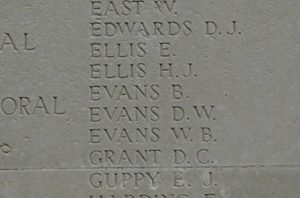
Herbert James Fisher, Lance Corporal, 1343, Welsh Guards. Herbert was born in 1891, the son of George James Fisher and Elizabeth Fisher (nee Rose), of 91, Cairns Street, Cathays, Cardiff. He enlisted into Cardiff City Police as a young man. Herbert left his position at Cardiff to enlist at Cardiff into the 1st Battalion, Welsh Guards upon its formation by Royal Warrant on 26 February 1915, and the battalion moved to France on 18 August 1915, where it became attached to the 3rd Guards Brigade, Guards Division. The Division saw its first major action during the Battle of Loos, which began on 25 September 1915. During the opening day, the Guards Division began moving into position, watching the terrible scenes in front of them, before launching its own attack on the following morning. At around 18.00 that day the Welsh Guards received orders to attack a feature called Hill 70, and as the men slowly made their way forwards, darkness fell. As soon as the battalion reached the top of the Hill, German machine-gunners opened up a murderous fire on them, forcing the men to dig into the many shell holes littering the crest, before retiring to positions just below of the crest, where the survivors dug-in. After further fighting at the Hohenzollern Redoubt, the Guards Division had a brief rest in the Calais area, before moving to the Ypres Salient, and held the line at Potijze for several months. At the end of July 1916, the Division withdrew from Ypres and moved to the Somme, before holding the line north of the Ancre for a short period. By 25 August the Guards Division had moved slightly south, and had marched passed Corbie, to Mericourt-L’Abbe. By 9 September the Guards had passed Ginchy, and moved into positions at Guillemont, prior to taking part in the Battle of Flers-Courcelette, the first-time tanks were ever used in action. The battle opened on 15 September 1916, with massed tanks advancing against the German lines, supported by infantry. Although initially successful, the majority of the tanks either broke down or were put out of action. Herbert was killed in action near Ginchy on the following day, 16 September 1916, whilst the Welsh Guards attacked positions north of Ginchy. The 27-year-old has no known grave and is commemorated on the Thiepval Memorial, France.

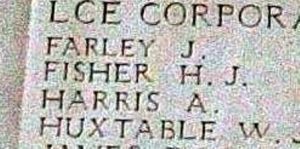
Frank Ford, Private, 6713, Coldstream Guards. Frank was born at Gosport, Hampshire on 21 March 1888, the son of Elijah Ford and Emily Jane Ford (nee Wilkins). His father died soon after his birth, so Frank went to live with his aunt, Charlotte Perry, at Heathfield, West Monkton, Somerset. By 1901 Frank and his mother were residing with her father, John Wilkins, at Bathpool, West Monkton. Frank left home and enlisted into the Coldstream Guards on 22 March 1906, serving for seven years before leaving the army and joined Cardiff City Police in 1913. He was stationed at Canton. Following the outbreak of war, as an Army Reservist, Frank was mobilised and joined his old battalion, the 1st Battalion, Coldstream Guards, at Windsor. The battalion was attached to the 1st (Guards) Brigade, 1st Division and embarked for France at Southampton on 13 August, disembarking at La Havre the following day. The division then entrained for the Belgian Frontier, reaching La Nouvion by 16 August, then marched in stages to Rouvroy, where they crossed the border into Belgium. On 23 August 1914 the Germans launched an overwhelming attack against the Belgian town of Mons, and the British and French were forced to withdraw. The 1st Division took part in the fighting that day, before being forced to withdraw together with the remainder of the BEF, taking part in the epic retreat to the Marne, where the German drive on Paris was stopped at the Battle of the Marne, which was fought from 5 September to 12 September. The Germans were then forced to withdraw, taking up positions along the Chemin-des-Dames Ridge, where the BEF attacked them on 13 September. This Battle of the Aisne saw the formation of the line of trenches which was to become known as the Western Front, as the Germans dug themselves in along the Chemin-des-Dames, and the BEF began moving to Flanders on 14 October, to prevent the Germans breaking through towards the Channel ports and took over positions guarding the strategically important city of Ypres, the 1st Division taking up positions near Langemarck by 21 October. Later that day the division was attacked by hordes of Germans, mainly young student-soldiers, who were mown down by the highly trained British soldiers. The Germans maintained their attacks over the coming days but were held at bay, sustaining terrible losses. Frank was killed in action at Langemarck on 25 October 1914, just before his battalion was relieved. The 26-year-old has no known grave and is commemorated on the Ypres (Menin Gate) Memorial, Belgium.
Albert Hollyman, Private, 103, Welsh Guards. Albert was born in 1887, the son of Frederick Hollyman and Helen Hollyman (nee Bathe), of 37, Scott Street, Cardiff. His father died in 1891, and his mother was sent to the Glamorgan Workhouse. Ellen then married Charles Purnell, of 17, Court Road, Canton and Albert and his five younger siblings were reunited with their mother. By 1911 Albert was lodging with his elder brother George at 26, Craddock Street, Canton and was working as a coal trimmer. He married Gladys Lewis later that year and the couple set up home at 63, Treharris Street, Roath. Albert then enlisted into the Cardiff City Police at some time after this. He enlisted into the Grenadier Guards, together with several of his colleagues, as soon as war was declared, but following the formation of the Welsh Guards by Royal Warrant of 26 February 1915, he transferred to the new regiment, which was billeted at the White City. The new 1st Battalion, Welsh Guards landed at Le Havre on 18 August 1915, becoming attached to 3rd Guards Brigade, Guards Division and saw its first major action during the Battle of Loos, which began on 25 September 1915, remaining in the area during the coming months, where they also fought in the subsequent Action of Hohenzollern Redoubt. In July 1916 the Division moved to the Somme, where it fought at the Battle of Flers-Courcelette, and then at the Battle of Morval, capturing Lesboeufs Village. The division remained here for the winter, and in March 1917 took part in the advance caused by the German Retreat to the Hindenburg Line. Later that year it moved north to Ypres, where it fought at the opening Battle of the Pilckem Ridge, and then took part in further fighting at the Battle of the Menin Road, Battle of Poelcapelle and the First Battle of Passchendaele. November saw the division move south again, where it took part in the Battle of Cambrai. The division remained in the area over the final winter of the war and was stationed near Gouzeaucourt when the German Spring Offensive hit the area on 21 March 1918, seeing heavy fighting as the line was driven back. After this, the German Offensive petered out on the Somme, and on 8 August the Australian Corps advanced towards the town of Villers Bretonneux and won a mighty battle there against the Germans, thus turning the war. On 21 August the British launched an attack on the Somme, and the Guards Division fought here at the Battle of Albert, and then pushed east, fighting at the Battle of Bapaume. From here on the Allies had the upper hand, and moved towards the Hindenburg Line, where the Guards Division fought at the Battle of Havrincourt and the Battle of the Canal du Nord. Once the Hindenburg Line had been broken, the Allies swept eastwards over territory that had been occupied by the Germans for four long years. The Guards fought at the Battle of Cambrai, and then the Pursuit to the Selle, the Battle of the Selle and the Battle of the Sambre. Albert had survived all of the terrible fighting which the Welsh Guards became caught up in, only to become ill during the final weeks of the war and was evacuated to the 26th General Hospital at Étaples, where he died of pneumonia on 21 October 1918. The 32-year-old was buried in Étaples Military Cemetery, France.
Henry Ernest James, Sergeant, 7866, Gloucestershire Regiment. Henry was born in 1890, the son of Thomas James and Jane Elinor James (nee Gardner), of Thames Head Cottage, Coates, Gloucestershire. He left home to enlist into the army as a young man and by 1911 was serving with the 2nd Battalion, Gloucestershire Regiment. His elder brother, Thomas, was by now serving as a policeman in Cheltenham, so Henry followed in his footsteps, leaving the army and joining the Cardiff City Police. As soon as war broke out, Henry, an Army Reservist due to his previous service, was mobilised and re-joined the 1st Battalion, Gloucestershire Regiment at Bardon, in Hampshire. The battalion was attached to 3 Brigade, 1st Division, together with the 1st SWB and 2nd Welsh, and embarked for France, landing at Le Havre on 13 August, before entraining with the rest of the 1st Division for the Belgian frontier, taking up positions near the town of Mons. The Division then took part in the Battle of Mons on 23 August, following the German invasion of the low countries, and in the epic withdrawal from Mons to the River Marne, where the German drive on Paris was halted. The Germans then withdrew north and took up defensive positions north of the river Aisne, along the Chemin des Dames Ridge and the BEF advanced before launching a frontal attack upon the German positions. This battle saw the beginning of the formation of the Western Front, as the Germans dug in along the Chemin-des-Dames ridge, and the BEF began moving to Flanders on 14 October, before advancing from Poperinghe past endless numbers of refugees and took up positions guarding the strategically vital city of Ypres, the 1st Division taking up positions near Langemarck by 21 October. Later that day the division was attacked by hordes of Germans, mainly young student-soldiers, who were mown down by the highly trained British soldiers. The Germans maintained their attacks over the coming days but were held at bay, sustaining terrible losses, and the line here stabilised, so by 27 October the 1st Division moved to positions near Zandvoorde, guarding the Menin Road. On 31 October 1914 the 1st Division faced its sternest test so far, when the Germans attacked its positions on the Menin Road, behind a fearsome artillery bombardment. Terrible fighting during the day saw 3 Brigade virtually annihilated, and the battered division was relieved days later, before moving to quieter positions to the south, north-east of Bethune, near Richebourg. On 21 December 1914 the 1st Division mounted an attack to regain trenches lost by the Indian Corps at Festubert. The 1st Gloucester’s managed to regain some 500 yards of trenches but had suffered some 200 casualties. Henry had been killed in action during the attack that day. The 24-year-old is buried in Guards Cemetery, Windy Corner, Cuinchy, France.
Thomas Lemuel Jones, Private, 15211, Grenadier Guards. Lemuel was born in 1894, the son of Thomas Jones and Anne Jane Jones (nee Jenkins), of Nanybyr, Ystumtuen, Cardiganshire. He left home as a young man and was lodging at 21, Bridgend Road, Pontycymmer, where he worked as a collier. Thomas then left his job at Pontycymmer and enlisted into Cardiff City Police. As soon as war erupted, he left his job to enlist together with several other Cardiff Policemen into the 2nd Battalion, Grenadier Guards, which was in barracks at Chelsea, as part of the 4th (Guards) Brigade, 2nd Division. Thomas landed at le Havre with the battalion on 15 August 1914, and the entire 2nd Division entrained for the Belgian frontier, taking up positions around the town of Mons. On 23 August 1914 the Germans attacked the city and after a fierce fight, the vastly outnumbered BEF was forced to withdraw. During the epic retreat from Mons, the 2nd Division took part in the Affair of Landrecies and in the Rearguard Actions of Villers-Cotterets, before the German drive on Paris was stopped at the Battle of the Marne, which was fought from 5 September to 12 September. The Germans were then forced to withdraw, taking up positions along the Chemin-des-Dames Ridge, where the BEF attacked them on 13 September. This Battle of the Aisne saw the formation of the line of trenches which was to become known as the Western Front, as the Germans dug themselves in along the Chemin-des-Dames, and the BEF began moving to Flanders on 14 October, to prevent the Germans breaking through towards the Channel ports, and took over positions guarding the strategically important city of Ypres. On 21 October the 2nd Grenadier Guards took over positions two miles west of Zonnebeke. To their north the 1st Division came under heavy attack that day, whilst on the 2nd Divisions front there was just the odd skirmish. The division launched an attack against Reutel on 25 October, but was beaten back, then on 27 October all hell broke loose, and the Germans attacked in great strength along the Menin Road, hitting positions taken over by the battered 1st Division. The 2nd Division was again outside the main battle zone, holding Polygon Wood, then moved to positions at Klein Zillebeke, just south of the 1st Division, which was virtually annihilated on 31 October. Thomas was killed in action whilst in the trenches at Klein Zillebeke, when the 2nd Grenadier Guards came under heavy artillery fire on 10 November 1914. The 20-year-old has no known grave and was most likely buried in the trenches by the bombardment, so is commemorated on the Ypres (Menin Gate) Memorial, Belgium. (The Menin Gate Memorial is incorrectly inscribed as T.S. Jones).
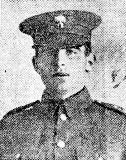
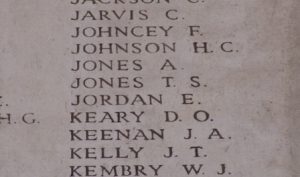
George Henry Lock, Private, 1347, Welsh Guards. George was born in 1890, the son of George Henry Lock and Eliza Lock (nee Nethercott), of 54, Richards Terrace, Roath, Cardiff. He worked as a bricklayer prior to enlisting into Cardiff City Police at some time prior to the war. George enlisted at Cardiff together with several colleagues into the Welsh Guards following the formation of the new regiment by Royal Warrant of 26 February 1915, at White City, before landing at Le Havre on 18 August 1915, becoming attached to 3rd Guards Brigade, Guards Division. The Division saw its first major action during the Battle of Loos, which began on 25 September 1915. During the opening day, the Guards Division began moving into position, watching the terrible scenes in front of them, before launching its own attack on the following morning. At around 18.00 that day the Welsh Guards received orders to attack a feature called Hill 70, and as the men slowly made their way forwards, darkness fell. As soon as the battalion reached the top of the Hill, German machine-gunners opened up a murderous fire on them, forcing the men to dig into the many shell holes littering the crest, before retiring to positions just below of the crest, where the survivors dug-in. The battered division remained at Loos, taking part in the Action of the Hohenzollern Redoubt. The Division then had a brief rest in the Calais area, before moving to the Ypres Salient, and held the line at Potijze for several months. The Welsh Guards spent two weeks out of the line at Wormhoudt, before moving back to L Camp, near Poperinghe by 16 June, where the men were informed of a German gas attack at Hooge, and the sound of battle could be heard coming from the front. On the following night the battalion moved forward and took over positions along the Canal Bank sector, near Bridge 4. The trenches were in a terrible condition and the men were put to work on trench improvements over the coming days before being relieved and moving back to Chateau Des Trois Tours at Brielen. On 28 June the Welsh Guards moved back into the line to begin another routine tour in the trenches and prepared to launch a raid against the Mortjelde Estaminet, a German strongpoint facing their positions. George was killed in action during the raid, which took place during the evening of 1 July 1916. The 25-year-old has no known grave and is commemorated on the Ypres (Menin Gate) Memorial, Belgium. Tragically for the family, two of his four sisters were widowed the following year: a brother-in-law, Robert John Hancock, was killed in Egypt on 1 December 1917, while another brother-in-law, Briant Ernest Hopgood, was killed at sea with the sinking of the SS Dowlais two days later.
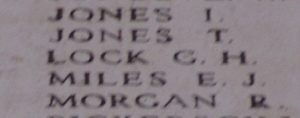
Percy John Marks, Lance Corporal, 1345, Welsh Guards. Percy was born in 1895, the son of Ernest Frank Marks and Kate Marks (nee Thorne), of 16, Noble Street, Taunton. He worked for his father at his dairy farm as a young man, before leaving home to enlist into the Cardiff City Police. Percy enlisted at Cardiff together with several colleagues into the Welsh Guards following the formation of the new regiment by Royal Warrant of 26 February 1915, at White City, before landing at Le Havre on 18 August 1915, becoming attached to 3rd Guards Brigade, Guards Division. The Division saw its first major action during the Battle of Loos, which began on 25 September 1915. During the opening day, the Guards Division began moving into position, watching the terrible scenes in front of them, before launching its own attack on the following morning. At around 18.00 that day the Welsh Guards received orders to attack a feature called Hill 70, and as the men slowly made their way forwards, darkness fell. As soon as the battalion reached the top of the Hill, German machine-gunners opened up a murderous fire on them, forcing the men to dig into the many shell holes littering the crest, before retiring to positions just below of the crest, where the survivors dug-in. The battered division remained at Loos, taking part in the Action of the Hohenzollern Redoubt. The Division then had a brief rest in the Calais area, before moving to the Ypres Salient, and held the line at Potijze for several months. At the end of July 1916, the Division withdrew from Ypres and moved to the Somme, before holding the line north of the Ancre for a short period. By 25 August the Guards Division had moved slightly south, and had marched passed Corbie, to Mericourt-L’Abbe. By 9 September the Guards had passed Ginchy, and moved into positions at Guillemont, prior to taking part in the Battle of Flers-Courcelette, the first-time tanks were ever used in action. The Guards Division saw heavy fighting at Flers, and then during the ensuing Battle of Morval, capturing Lesboeufs Village. After the Somme offensive had died down, the Guards remained on the Somme for the winter, taking part in the advance caused by the German withdrawal to the Hindenburg Line in March 1917. The Guards Division then moved back to the Ypres Salient, taking over positions along the Canal Bank Sector, north of Boesinghe, and prepared for the forthcoming Passchendaele offensive. On 31 July 1917 the Guards Division attacked in conjunction with the 38th (Welsh) Division, securing Pilckem Ridge. After a brief rest at Proven the Welsh Guards rebuilt before moving back into the line near Langemarck on 31 August, to re-join the battle. Percy was killed in action here by enemy shellfire on 4 September 1917. The 22-year-old is buried in New Irish Farm Cemetery, Belgium.
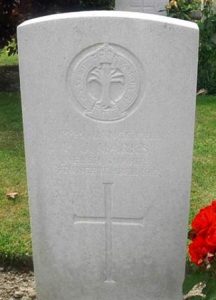
Henry James Porter, Gunner, 161473, Royal Garrison Artillery. Henry was born in 1892, the son of Esau Porter and Eliza Porter (nee Sparks), of Poples Cottage, Goathurst, Somerset. He worked as a farm labourer there prior to leaving home to enlist into the Cardiff City Police. Henry married Margaret Manx Pope, a domestic servant from Penarth, at Llandaff on 26 September 1916, and the couple lived at Roath Police Station. Henry had enlisted at Cardiff into the Royal Garrison Artillery on 12 February 1916 and had been placed on the Army Reserve, so continued to serve as a police officer until being mobilised on 22 May 1917 and was posted to Fort Brockhurst in Hampshire for training. He was drafted to France on 12 June 1917 and joined the 452nd Siege Battery, Royal Garrison Artillery. Henry served on the Western Front until being severely wounded in April 1918, following the launching of the German spring offensive, and was evacuated home to Britain, suffering from gunshot wounds to his thighs and genitals. Upon recovering from his wounds, he was posted to Catterick, but was by now quite poorly and was hospitalised again. Henry died of bronchitis at the 2nd Eastern General Hospital at Brighton on 6 January 1919. The remains of the 26-year-old were brought home and he was buried in Cardiff (Cathays) Cemetery.
Walter John Twining, Lance Corporal, 23217, 10th (Prince of Wales’s Own Royal) Hussars. Walter was born on 29 November 1884, the son of Maurice Tom Twining and Caroline Twining (nee Liffully), of the Calley Arms Inn, Hodson Village, near Swindon. He left home as a young man and enlisted into the 10th Royal Hussars alongside his brother Arthur in 1901, serving for several years before leaving the army in 1909 and found work for the Great Western Railway at Dowlais. Walter had joined the Cardiff City Police by 1911 and was living at Bute Street Police Station. As a former soldier he was an Army Reservist, so was mobilised at the outbreak of war, re-joining his old regiment, the 10th Royal Hussars. The regiment had been in Potchefstroom when war broke out, before embarking at Cape Town for England, joining the 6th Cavalry Brigade. 3rd Cavalry Division at Ludgershall. On 8 October 1914 the division landed at Ostend, but the Germans had already begun their invasion of Belgium, so the division was thrown into heavy fighting almost immediately, during the defence of Antwerp the following day, before withdrawing towards the Belgian city of Ypres, passing through Roulers on 12 October, where the men billeted, before marching to Ypres the following day, then the division advanced and took up positions along a line running from Ypres – Warneton – Zillebeke – Combines – Becelaere to Werviez before moving onto positions near Poelcapelle. The 10th Hussars were very mobile at this time, until the Germans made their first attacks on 21 October, thus heralding the opening of the First Battle of Ypres. Over the coming days the 3rd Cavalry Division took part in the Battle of Langemarck, then in the Battle of Gheluvelt, before taking part in further fighting at Nonne Boschen on 11 November. On 17 November 1914 the Germans attacked again, and the division, holding the line between Hooge and Zillebeke, came under heavy fire. Walter was killed in action during the day. The 29-year-old has no known grave and is commemorated on the Ypres (Menin Gate) Memorial, Belgium.
Frank Scott Willis, Private, 6352, Coldstream Guards. Frank was born in 1886, the son of Andrew Gabriel Willis and Amelia Sophia Willis (nee Huntley), of 12, Pack Street, Minehead. He trained as a butcher prior to enlisting into the Coldstream Guards as a young man, but by 1911 had left the army to work for Cardiff City Police and was residing at the Police Station at Janet Street, Cardiff. As an Army Reservist, Frank was mobilised at the outbreak of war and was posted to the 3rd Battalion, Coldstream Guards. Frank joined up with the battalion at Chelsea Barracks, where it was attached to the 4th (Guards) Brigade, 2nd Division. On 13 August the division landed at Le Havre, then proceeded by train to the Belgian frontier, taking up positions near the town of Mons. On 23 August 1914 the Germans attacked the city and after a fierce fight, the vastly outnumbered BEF was forced to withdraw. During the epic retreat from Mons, the 2nd Division took part in the Affair of Landrecies and in the Rearguard Actions of Villers-Cotterets, before the German drive on Paris was stopped at the Battle of the Marne, which was fought from 5 September to 12 September. The Germans were then forced to withdraw, taking up positions along the Chemin-des-Dames Ridge, where the BEF attacked them on 13 September. This Battle of the Aisne saw the formation of the line of trenches which was to become known as the Western Front, as the Germans dug themselves in along the Chemin-des-Dames, and the BEF began moving to Flanders on 14 October, to prevent the Germans breaking through towards the Channel ports, and took over positions guarding the strategically important city of Ypres. On 21 October the 2nd Grenadier Guards took over positions two miles west of Zonnebeke. To their north the 1st Division came under heavy attack that day, whilst on the 2nd Divisions front there was just the odd skirmish. The division launched an attack against Reutel on 25 October, but was beaten back, then on 27 October all hell broke loose, and the Germans attacked in great strength along the Menin Road, hitting positions taken over by the battered 1st Division. The 2nd Division was again outside the main battle zone, holding Polygon Wood, then moved to positions at Klein Zillebeke, just south of the 1st Division, which was virtually annihilated on 31 October. The 3rd Coldstream Guards took over trenches facing Reutel and Becelaere and endured a very testing time over the coming days. Although not subjected to an infantry attack, the battalions’ lines were bombarded daily by German howitzers firing shrapnel over their heads. Frank was killed in action whilst in the line here on 15 November 1914, just a day prior to the battalion being relieved. The 28-year-old is buried in Railway Chateau Cemetery, Belgium.
Milton Horace Wood, Private, 5841, Royal Army Medical Corps. Milton was born as Milton Horace Hoyland in Dewsbury, Yorkshire in 1888. By 1891 he was residing with his Aunt Zilpah Wood (nee Hoyland), and her husband Harry Wood at 38, Thomas Street South, Halifax. Milton had gained work as a Brewer’s Clerk by 1911 but following the death of his adopted mother the following year enlisted into the Cardiff City Police Force. Milton enlisted into the Royal Army Medical Corps as soon as war was declared and on 15 August 1914 embarked for France with the staff of the 3rd General Hospital, RAMC. He married Frances May Davies, of Brecon, on 12 December 1915 whilst home on leave, and their only child, a daughter Sybil Iris Wood, was born on 11 September 1916. Milton returned to duty on the Western Front after his marriage, but in May 1917 was transferred to another unit in Egypt. On 3 May 1917 he boarded the requisitioned steamer HMT Transylvania at Marseilles and later that day the ship set sail for Alexandria with an escort of two Japanese destroyers, the Matsu and the Sakaki. At 10.00 on the following day, Transylvania was struck in the port engine room by a torpedo from the German submarine U-63 whilst off the Cape Vado in the Gulf of Genoa. The damaged ship headed for land, whilst the Matsu came alongside to take off the troops. Soon afterwards a second torpedo hit Transylvania which sank within 30 minutes. Milton was among some 400 men and women who drowned during the sinking of the Transylvania that day, 4 May 1917. The 29-year-old has no known grave and is commemorated on the Savona Memorial, Italy. His widow Frances lost her brother Wilfred John Davies during the war, when he was killed on the Somme in 1916. After the war she married Charles Lewis Davies, the owner of the Wheatsheaf Inn at Brecon.
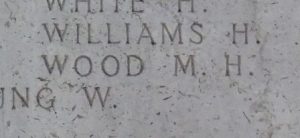
World War Two, 1939-1945
Ronald Walter Beechey, Flying Officer, 176445, Royal Air Force Volunteer Reserve. Ronald was born on 12 April 1919, the son of William John Beechey and Emma Beechey (nee James), of 16, Monthermer Road, Cardiff. He was serving as a police constable at Cardiff by 1939 and was still residing with his parents. Ronald married Beryl Rosaline Gronow at Cardiff in the summer of 1941. He enlisted into the Royal Air Force Volunteer Reserve and after training as a pilot was posted to 640 Squadron, Royal Air Force, which was a heavy bomber unit, based at RAF Leconfield, in Yorkshire. On the night of 4 November 1944, Ronald took off from Leconfield aboard a Handley Page Halifax III, Serial MZ409, which joined a force of some 749 aircraft despatched to strike targets at Bochum, in Germany. The raid was very successful, with severe damage caused to the town and its steelworks, but at the cost of almost 1,000 German lives. Ronald was killed that night when his Halifax was shot down and crashed near Vohwinkel, with the loss of all seven of her crew. The 25-year-old was originally buried in a collective grave with his fellow crewmen in Vohwinkel Protestant Cemetery, but in September 1947 their graves, together with those of several other RAF servicemen, were exhumed and re-interred in Rheinberg War Cemetery, Germany.
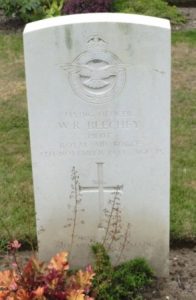
Herbert Sidney Bennett, Flight Sergeant, 1339124, Royal Air Force Volunteer Reserve. Herbert was born in Cardiff on 19 May 1919, the son of Lieutenant Herbert Sidney Bennett and Gertrude Bennett (nee Lyons David). His father was killed in France whilst serving with the South Wales Borderers in October 1919, so never got to see his son. Herbert was serving with the Cardiff City Police by 1939 and was lodging at 29, Denton Road, Cardiff, with two other officers. He married Dorothy Frances Sophie Hilborne at Cardiff in the summer of 1942. Herbert enlisted into the Royal Air Force Volunteer Reserve and trained as an Air Bomber before being posted to 550 Squadron, Royal Air Force, which was a heavy bomber unit, stationed at RAF Waltham, in Lincolnshire. On the night of 2 December 1943, Herbert took off from RAF Grimsby, a satellite station, aboard an Avro Lancaster I, Serial LM301, which joined a large force of aircraft sent to destroy targets in Berlin. Herbert was killed when the Lancaster was intercepted by a German night fighter and crashed at Wasbuttel during the following morning, 3 December 1943. The 24-year-old was originally buried with five of his fellow crew members in a communal grave in Wasbuttel Cemetery, but in May 1947 their graves were exhumed and re-interred in Hanover War Cemetery, Germany.
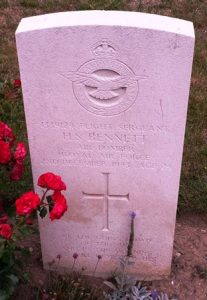
Walter Bernard England, Lance Corporal, 14270708, Royal Armoured Corps. Bernard was born in 1922, the son of William Charles England and Ellen England (nee Taylor), of the Railway Street Schoolhouse, Cardiff. He enlisted into Cardiff City Police as a young man, before leaving his post to enlist into the Royal Armoured Corps, and was posted to the 144th Regiment, Royal Armoured Corps. The regiment had been formed from the 8th Battalion, East Lancashire Regiment in November 1941 and was assigned to the 33rd Tank Brigade. The regiment trained in the infantry tank role with Churchill tanks, and had been mobilised for Sicily, but was instead forced to convert to Shermans and handed over its Churchill’s to a Canadian unit. Following the D-Day invasion on 6 June 1944, the regiment began landing on the Normandy beaches over the ensuing days, equipped with Crusader tanks and moved into positions near Bayeux, where it began some reconnaissance work. The units first major action was during Operation Pomegranate, supporting the 59th (Staffordshire) Infantry Division in an attack on Noyers, where the 144th Regiment suffered the loss of some 20 tanks, mainly from mines. Bernard was killed in Normandy on 17 July 1944, probably as a result of one of these losses to minefields. The 22-year-old has no known grave and is commemorated on the Bayeux Memorial, France.
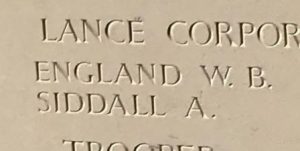
Daniel Hopkins, Sergeant, 1317702, Royal Air Force Volunteer Reserve. Daniel was born on 22 September 1918, the son of Thomas Hopkins and Clementina Hopkins (nee Compton), of Porth. By 1939 he was serving with Cardiff City Police and was residing at 20, Pen y Peel Road, Canton, Cardiff. Daniel enlisted into the Royal Air Force Volunteer Reserve and after training as an Air Bomber was posted to 101 Squadron, Royal Air Force, which was a heavy bomber unit, stationed at RAF Ludford Magna, in Lincolnshire. On the night of 3 September 1943, Daniel took off form Ludford Magna aboard an Avro Lancaster III, Serial ED659, which joined a large bomber force despatched to strike targets in Berlin. During the early hours of 4 September 1943, the Lancaster was hit by German flak and crashed near Gatow airfield, near to its target, killing all seven of her crew. Daniel was 25 years old when he was lost during the crash that morning. He was originally buried in a communal grave together with his six fellow crewmen in Doeberitz Standortfriedhof, but in October 1946 the war graves within the cemetery were removed and re-interred into Berlin 1939-1945 War Cemetery, Germany.
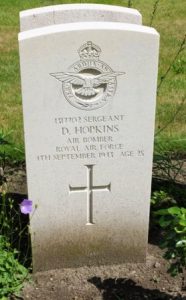
Vincent Longmead Hyatt, Flying Officer, 132394, Royal Air Force Volunteer Reserve. Vincent was born on 19 March 1916, the son of Harry Hyatt and Florence Clara Hyatt (nee Smith), of Cardiff. By 1939 he was working as a Police Fireman and was residing at 227-8, Bute Street, Cardiff. Vincent enlisted into the Royal Air Force Volunteer Reserve and after training as a Navigator, was posted to 102 Squadron, Royal Air Force, which was a heavy bomber unit, based at RAF Pocklington, in Yorkshire. On the night of 2 October 1943, Vincent took off from Pocklington aboard a Handley Page Halifax II, Serial JD276, which had been sent out on a night training exercise. During the following morning, 3 October 1943, the aircraft was making an approach to land at Pocklington when it overshot the airfield, so circled around to try again. The aircraft suddenly lost height and crashed into the ground near the village of Hayton, killing Vincent and three of his fellow crewmen instantly. Three others died in York hospital of their injuries over the coming days. Vincent was 27 years old when he was killed that morning, and was buried in St. James’ Churchyard, Bratton, a small village in Wiltshire that his father had recently retired to.
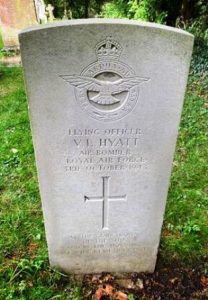
Derrick Isaac Jones, Flying Officer, 120809, Royal Air Force Volunteer Reserve. Derrick was born in 1920, the son of David John Jones and Margaret Ann Jones (nee Owen), of 7, Water Street, Carmarthen. He served with Cardiff City Police before enlisting into the Royal Air Force Volunteer Reserve and trained as a Navigator before being posted to No 1 (Coastal) Operational Training Unit, to complete his training. On 10 November 1942, Derrick was flying as Navigator aboard a Lockheed Hudson, Serial AM680, on a night navigation exercise, when the aircraft struck high ground at Beda Fell, Ullswater, killing all four of her crew. Derrick was 22 years old when he died during the crash that day. His remains were conveyed home and he was buried in Carmarthen Cemetery.
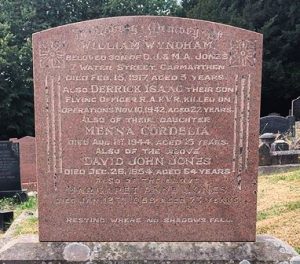
Thomas Charles Laing, Flying Officer, 135875, Royal Air Force Volunteer Reserve. Thomas was born on 27 September 1919, the son of Frederick William James Laing and Ada Naomi Laing (nee Ayliffe), of 94, Railway Street, Roath, Cardiff. He was serving with the Cardiff City Police by 1939, and was living with his parents at 25, Lily Street, Cardiff. He enlisted into the Royal Air Force Volunteer Reserve and trained as a Navigator before being posted to 576 Squadron, Royal Air Force, which was a heavy bomber unit, stationed at RAF Elsham Wolds, in Lincolnshire. On the night of 27 January 1944 Thomas took off from Elsham Wolds aboard an Avro Lancaster I, Serial ME593, which joined a large bomber force despatched to strike Berlin. Thomas was killed that night, 27 January 1944, when the Lancaster was shot down en-route to Berlin and crashed with the loss of all seven of her crew. Thomas’s remains were reportedly discovered by an American unit and he was originally buried by them in Neuville American Cemetery in Belgium, separate from the rest of his fellow crew, who were buried in a collective grave in Luderitz, Germany. Thomas’s remains were exhumed in June 1948 and he was re-interred in Heverlee War Cemetery, Belgium. His fellow crewmen were also exhumed and were re-interred in Berlin 1939-1945 War Cemetery, Germany.
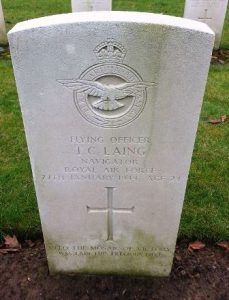
Reginald Alfred William Meechem, Guardsman, 2733122, Welsh Guards. Reginald was born on 21 April 1912, the son of Alfred Edward Meechem and Florence Annie Meechem (nee Ballinger), of 101, Splott Road, Cardiff. His father was a police sergeant with Cardiff City Police and Reginald followed his father into the profession, becoming a police officer with the same force at Bridge Street Police Station by 1934. In 1937 Reginald had married Edith Maud Wiggin and the couple resided at 56, Chamberlain Road, Cardiff. As soon as war erupted, Reginald enlisted into the 2nd Battalion, Welsh Guards, which had been raised in May 1939 at the Tower of London. The battalion joined the newly formed 20th Guards Brigade at Camberley on 22 April 1940. Following the German invasion of the low countries on 10 May, the 2nd Welsh Guards were ordered back from leave and to pack for embarkation. On 21 May the battalion arrived at Dover and embarked aboard the SS Biarritz and disembarked at Boulogne on the following day. The battalions orders were simply to defend Boulogne and during that afternoon the first German patrols were spotted before the Germans attacked Boulogne, supported by tanks. Heavy fighting raged throughout the night and the following day, and by the time the survivors of the 2nd Welsh Guards were evacuated on 25 May, some 453 men were captured. Reginald was last seen alive on 24 May and was thought to have been taken prisoner during the fall of Boulogne, but his body was recovered from the sea off Holland on 17 June 1940. The 28-year-old was buried in Hook of Holland General Cemetery. His official date of death is 13 May 1940, the same as another Welsh Guardsman, Arthur William Cornelius, who is buried with him.

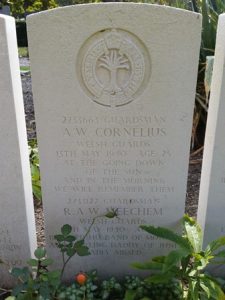
Walter Henry Morgan, Flying Officer, 134667, Royal Air Force Volunteer Reserve. Walter was born on 6 May 1919, the son of George Henry Morgan and Rosa Mary Morgan (nee Good), of 18, Beauchamp Street, Cardiff. By 1939 the family had moved to 54, Connaught Road, Cardiff and Walter had enlisted into the Cardiff City Police. He left Cardiff to enlist into the Royal Air Force Volunteer Reserve and after training as an Air Bomber was posted to 467 (Australian) Squadron, Royal Air Force, which was a heavy bomber unit, based at RAF Bottesford, in Leicestershire. On the night of 12 July 1943 Walter took off from Bottesford aboard an Avro Lancaster III, Serial ED531, which joined a large bomber group despatched to strike strategic targets in Turin. On the outward journey the following morning, Walter’s Lancaster strayed into Swiss air space, due to heavy winds, and was damaged by flak. The pilot dropped his bomb load, but due to poor weather the Lancaster flew into high ground at Thyon-les-Collons, killing all seven men aboard. Walter was 24 years old when he perished that morning. He was buried beside the remains of his crew in Vevey (St. Martin’s) Cemetery, Switzerland.
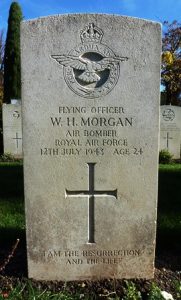
Stanley Walter Sayce, Flight Sergeant, 1318013, Royal Air Force Volunteer Reserve. Stanley was born on 20 March 1919, the son of Albert Edmund Sayce and Sophia Kate Sayce (nee Trigg), of 26, Newport Road, Abercarn. He followed in his fathers footsteps by enlisting into the police and served with Cardiff City Police prior to the war. Stanley married Jessie Forrest early in 1942. Stanley had enlisted into the Royal Naval Volunteer Reserve and trained as a Navigator before being posted to 207 Squadron, Royal Air Force, which was a heavy bomber unit, based at RAF Spilsby, in Lincolnshire. On the night of 5 April 1944 Stanley took off from Spilsby aboard an Avro Lancaster l, Serial ME685, which joined a large group of bombers despatched to strike the aircraft works at Montraudon, in Toulouse. During the early hours of the following morning, 6 April 1944, the Lancaster was hit by flak and exploded, crashing into the ground just outside Toulouse, killing all seven of her crew. Stanley was 25 years old when he died that morning and was buried together with his fellow crewmen in La Fourguette Communal Cemetery, Toulouse.
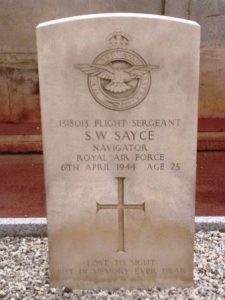
Christopher James Thorne, Pilot Officer, 186295, Royal Air Force Volunteer Reserve. Christopher was born on 28 December 1914, the son of Edwin Cornelius Thorne and Margaret Ann Thorne (nee Pride), of 13, Ruperra Street, Canton, Cardiff. He had enlisted into the Cardiff City Police by 1939 and was residing at 22, Springfield Place, Cardiff with his mother. Christopher enlisted into the Royal Air Force Volunteer Reserve and after training as an Air Bomber was posted to 101 Squadron, Royal Air Force, which was a heavy bomber unit, based at RAF Ludford Magna, in Lincolnshire. On the night of 11 October 1944 Christopher took off from Ludford Magna aboard an Avro Lancaster I, Serial LL771, which joined a force of bombers sent to carry out a raid on German gun batteries at Fort Frederik Hendrik, at Breskens. Christopher was killed when the Lancaster crashed into the ground near Heille, just southwest of the town of Aardenburg soon afterwards, and exploded with the loss of all eight of her crew. Christopher was 29 years old when he was killed that night and is buried together with the rest of his crew in Adegem Canadian War Cemetery, Belgium. An uncle, James Pride, was killed aboard HMS Defence during the Battle of Jutland on 31 May 1916, whilst another uncle, William Pride, had died of wounds at Bailleul just weeks previously.
William Young, Flying Officer, 163591, Royal Air Force Volunteer Reserve. William was born on 24 January 1915, the son of Thomas Young and Daisy Maud Young (nee Weeks), of 121, Mackintosh Place, Cardiff. He was serving as a Police Constable in Cardiff in 1939, and resided at 157, Allensbank Road. William married Mary Jane Peregrine, of Narberth, in 1939, soon after the outbreak of war. He enlisted into the Royal Air Force Volunteer Reserve and trained as a Navigator before being posted to 15 Squadron, Royal Air Force, which was a heavy bomber unit, operating from RAF Mildenhall, in Suffolk. On the morning of 5 January 1945 William took off from Mildenhall aboard an Avro Lancaster I, Serial LL923, as part of a group of 160 Lancaster’s despatched to bomb the railway yards at Ludwigshafen. The railway yards were hit, but a lot of damage was also done to the neighbouring communities and a large number of civilians were killed. William was killed during the raid, when his Lancaster was shot down and crashed near Beidesheim, killing all but one of her crew. The 29-year-old was originally buried with his fellow crewmen in Biedesheim Cemetery, but in April 1948 their graves were exhumed, and the six men were re-interred in Rheinberg War Cemetery, Germany.
